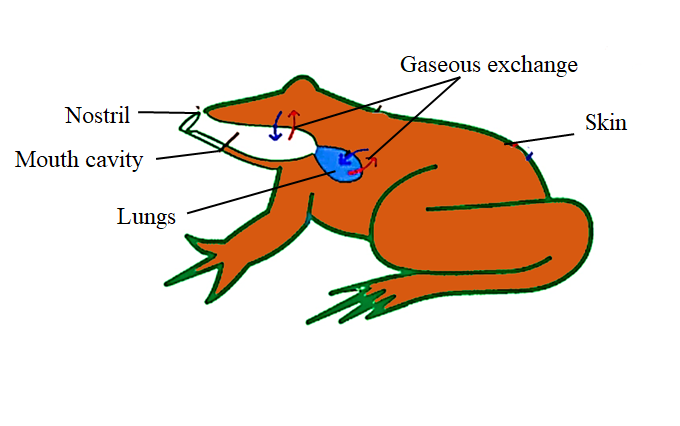
Why do amphibians breathe through skins and lungs?
Answer
578.7k+ views
Hint: They help in absorbing oxygen from the environment through the various body organs depending upon the environment they live in and the type of organism.
Complete step-by-step answer:
Respiration is the process of inhaling oxygen and exhaling carbon dioxide, it takes place through various organs depending upon the animals and their habitat. Respiration is an oxidation process which involves the degradation of a complex organic compound, this carbon dioxide, water, and energy are produced.
Certain amphibians like frogs have more than one organ of respiration during their life cycle. The frog performs respiration mainly through their skin even though the lungs are present. During different stages of their development, frogs breathe through different organs. The frogs when mature will mainly breathe through the lungs or through the skin also by exchanging gases with the environment.
The skin of the frog is mostly moist especially for the exchange of gases mainly oxygen inhaled and carbon dioxide exhaled. The surface of the skin is lined by several small blood vessels. Most frogs breathe through their noses with their mouths closed as they have lungs also to supplement their oxygen needs. Few amphibians do not have lungs and only breathe through their skin.
The land animals have lungs for breathing air, it may occur in aquatic animals also. The lungs get filled with air giving a frog a better buoyancy, making it float more easily. The amphibians breathe through the skin because when they are under the water then they will be able to absorb the oxygen only through the skin or else due to less oxygen they will drown in the water.

Note: There are three respiratory surfaces present on the body of the frog which is used during the process of exchange gas with the environment, they are; the skin, the lungs, and the lining of the mouth. Frogs have tympanum as a hearing organ present on either side of its head. The skin of the frog performs various functions including protection, absorption, respiration, and controls the body temperature.
Complete step-by-step answer:
Respiration is the process of inhaling oxygen and exhaling carbon dioxide, it takes place through various organs depending upon the animals and their habitat. Respiration is an oxidation process which involves the degradation of a complex organic compound, this carbon dioxide, water, and energy are produced.
Certain amphibians like frogs have more than one organ of respiration during their life cycle. The frog performs respiration mainly through their skin even though the lungs are present. During different stages of their development, frogs breathe through different organs. The frogs when mature will mainly breathe through the lungs or through the skin also by exchanging gases with the environment.
The skin of the frog is mostly moist especially for the exchange of gases mainly oxygen inhaled and carbon dioxide exhaled. The surface of the skin is lined by several small blood vessels. Most frogs breathe through their noses with their mouths closed as they have lungs also to supplement their oxygen needs. Few amphibians do not have lungs and only breathe through their skin.
The land animals have lungs for breathing air, it may occur in aquatic animals also. The lungs get filled with air giving a frog a better buoyancy, making it float more easily. The amphibians breathe through the skin because when they are under the water then they will be able to absorb the oxygen only through the skin or else due to less oxygen they will drown in the water.

Note: There are three respiratory surfaces present on the body of the frog which is used during the process of exchange gas with the environment, they are; the skin, the lungs, and the lining of the mouth. Frogs have tympanum as a hearing organ present on either side of its head. The skin of the frog performs various functions including protection, absorption, respiration, and controls the body temperature.
Recently Updated Pages
Master Class 12 Business Studies: Engaging Questions & Answers for Success

Master Class 12 Economics: Engaging Questions & Answers for Success

Master Class 12 English: Engaging Questions & Answers for Success

Master Class 12 Maths: Engaging Questions & Answers for Success

Master Class 12 Social Science: Engaging Questions & Answers for Success

Master Class 12 Chemistry: Engaging Questions & Answers for Success

Trending doubts
What is meant by exothermic and endothermic reactions class 11 chemistry CBSE

Which animal has three hearts class 11 biology CBSE

10 examples of friction in our daily life

One Metric ton is equal to kg A 10000 B 1000 C 100 class 11 physics CBSE

1 Quintal is equal to a 110 kg b 10 kg c 100kg d 1000 class 11 physics CBSE

Difference Between Prokaryotic Cells and Eukaryotic Cells




